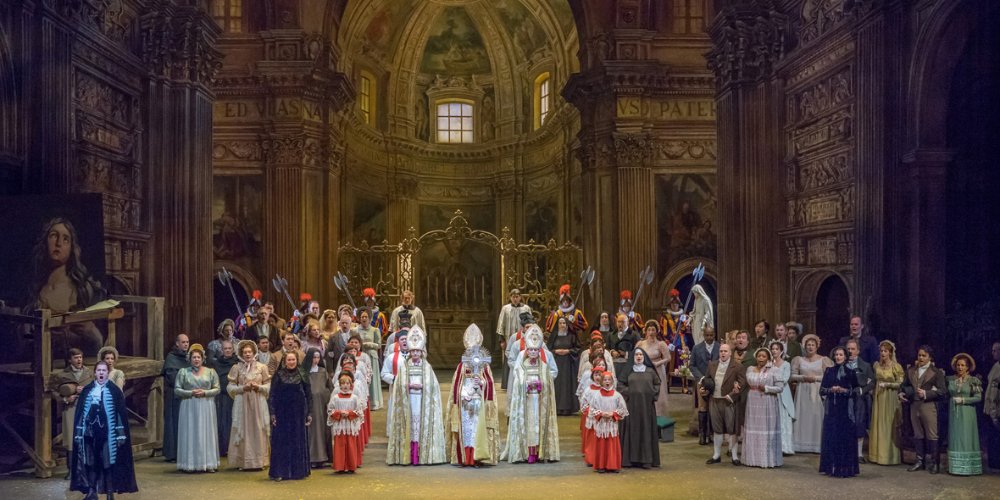Locals attending the current Seattle Opera production of Puccini’s “Tosca” might be forgiven a sense of deja vu. There is the frequency with which this old warhorse has been mounted (on average, every six years.) Half those productions have featured the same painted backdrops, or “soft scenery” again on display for this current run.
It’s a handsome set, created in Milan back in 1952, and purchased by impresario Glynn Ross for the 1969 Seattle production starring Dorothy Kirsten. The set features voluminous and detailed interiors for the Basilica of Sant’Andrea della Valle (Act One) and the Palazzo Farnese (Act Two).
Italian Conductor Leonardo Sini presided over the pit skillfully at the Sunday matinee, seeming to revel in the excellence of the orchestral playing. Highlighting Puccini’s seductive orchestration as Sini did sometimes came at the expense of impulse and dramatic edge. He wasn’t helped by a lugubrious Cesare Angelotti (bass Adam Lau) who as an ex-consul of the defunct Roman republic stumbles into the church, having just escaped from the Castel Sant’Angelo. Lau, whose cavernous, noble sound thrilled in January’s concert production of Les Troyens, sounded ponderous and behind the beat here.
His exit into the chapel cues the entrance of the Sacristan (baritone Barry Johnson); thankfully Johnson rather underplayed the part. His foil here is the dashing Mario Cavaradossi (tenor Rame Lahaj), who certainly looked the part of the Byronic hero, but whose voice betrayed some reticence. “Recondita armonia” came off sounding a bit like an audition piece, without the ardor suggested by the music.
With the arrival of Cavaradossi’s lover Floria Tosca (soprano Vanessa Goikoetxea) comes the duet, where ardor is essential. Two things became clear: Goikoetxea was in charge, her shine sometimes rubbing off on Lahaj, and the stage direction was adrift. The full-throated passion of the lovers made little sense as they capered about on separate pews.
The youth chorus preceding the arrival of Baron Scarpia (bass-baritone Craig Colclough) sounded well-rehearsed, soon cut off by Coclough’s growl, which suffused the stage with palpable menace. The chief of police slowly pieces together earlier events, and then with the re-entrance of Tosca begins to draw her into his scheme to capture the fugitive Angelotti. Goikoetxea managed this encounter well vocally, but her flailing hysteria tended to overshadow Coclough’s lecherous asides.
With the Te Deum came a new problem — how to situate the chorus for the Act One finale? I’ve visited the capella Attavanti at Sant’Andrea della Valle, and confirm that it’s located on the side of the great Baroque nave. The chapel is at center stage in this production, therefore a procession and seating ought to run from one side of the stage to the other. Instead, choristers seated themselves facing the audience, which sounded thrilling as the organ, bells, and cannons piled on. But the clergy with their croziers and thuribles had to zigzag through everyone to get to the off-stage sanctuary. This concession left this former architect nonplussed.
The edge on Colclough’s voice matched Scarpia’s debased musings at the opening of Act Two. Lahaj seemed to draw a blank during his interrogation. Scarpia sends Cavaradossi into an adjacent room to be tortured upon Tosca’s arrival, and the cat and mouse game begins.
After Tosca confesses Angelotti’s whereabouts at Cavaradossi’s villa and the bloodied hero is hustled off to the Castel Sant’Angelo, Scarpia makes his rapacious bargain plain: her lover’s life for a quick tumble. Now, as in any melodrama, it is the threat of violence that creates tension. Tosca is cornered first as a helpless witness to her lover’s torture, then by Scarpia into a horrific sexual bargain. A choice was made to subject this Tosca to violent groping, probably justified to show how a lecherous rapist like Scarpia looks through a modern lens. The problem is, once the violence occurs, the threat drains away, and with it the tension.
The vocal highlight of the show was Goikoetxea’s “Vissi d’arte,” and although she ran out of gas during the diminuendo preceding the final phrase, it was beautifully sung and rapturously received. Spoletta (tenor John Marzano) here accidently foils another groping episode to announce the suicide of Angelotti, and is detained by Scarpia long enough for Tosca to consent to his vile bargain and carry orders for a fake execution to the Castel Sant’Angelo. The final pizzicato strain of his rodentlike motif was perfectly rendered at his exit.
The stage business involving the dinner knife was very broadly acted, to the point of parody. Following Scarpia’s death Tosca’s actions were staged as a descent into madness. Her hysterical breakdown after “Or gli perdonno!” rang true.
Act Three opens with a shepherd’s love song, ably sung in the predawn starlight by treble Anthony E. Kim. The cello quartet that accompanies the conversation between the condemned Cavaradossi and his jailer outshone the aria that followed, which Lahaj sang with greater polish than his earlier aria but strangely clipped at the ends of phrases and without the requisite desperation.
Things come to a grinding halt with the arrival of Tosca, but the fault here lies with Puccini. To my mind, the composer felt compelled to pad the act with beautiful music of no dramatic freight. “O dolci mani,” is a tune cut from his youthful opera Edgar. The duet felt like packaging material, perhaps an attempt to impart to his opera some of the ecstasy his librettist Luigi Illica had brought to the finale of Andrea Chenier four years before. Tosca again seemed to be losing her mind throughout this exchange, maybe a visual cue to reinforce the lunacy of their escape plans. The iconic finale is bulletproof, unlike our hero.
Quibbles aside, this production is worth seeing, especially for the fantastic sound world that emanates from the pit.
Discover more from Post Alley
Subscribe to get the latest posts sent to your email.
